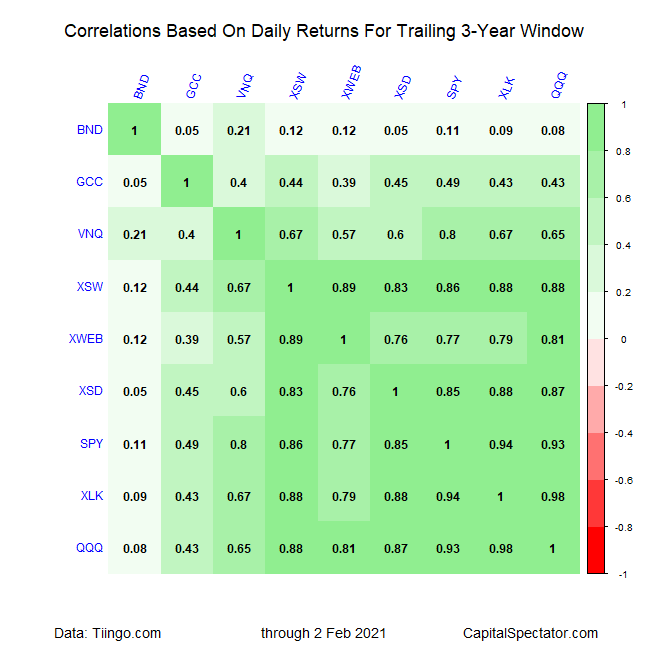It’s a tempting idea, and one that’s been bubbling for some time. The recent outperformance of tech stocks relative to the broad equity market has helped fuel the notion that this sector deserves to be treated differently.
“Technology wasn’t unimportant before COVID-19. But the pandemic and associated lockdowns have changed the calculus,” writes Duncan Stewart, an analyst at Deloitte Canada. In a thought-provoking article published by the CFA Institute, he lays out the case for seeing tech as something more than just another equity sector.
Increasingly, the question is not whether tech is important — it is — but just how important? What percentage of its time should a bank or retailer’s C-suite spend thinking about technology? How much of its annual spending should a firm allocate to tech? Twenty years after the dot-com bubble popped, what weighting should institutional and retail investors give the sector?
Tech certainly deserves a role in most if not all investment portfolios. But making the leap to carving out a distinct role for these stocks as asset class is still open for debate. It’s premature to dismiss the idea, but it’s not yet clear that it’s time to go all-in either. Deeper analysis is needed.
Let’s start with a quick look at how Mr. Market prices tech relative to the usual suspects across the asset class spectrum by way of return correlations. As proxies for the tech sector, we’ll use four ETFs, including Invesco QQQ Trust (NASDAQ:QQQ), which is loaded up with the likes of Apple (NASDAQ:AAPL), Microsoft (NASDAQ:MSFT) and Amazon (NASDAQ:AMZN). For additional perspective, we’ll also slice and dice by a broad sector-based measure (Technology Select Sector SPDR® Fund (NYSE:XLK)) and three industry subsets: software (SPDR® S&P Software & Services ETF (NYSE:XSW)), internet (SPDR® S&P Internet ETF (NYSE:XWEB)), and semiconductor (SPDR® S&P Semiconductor ETF (NYSE:XSD)).
The question is whether tech exhibits a noticeably lower return correlation vis-à-vis the broad stock market (Spdr® S&p 500 (NYSE:SPY)) and other conventionally defined asset classes: US bonds (Vanguard Total Bond Market Index Fund ETF Shares (NASDAQ:BND)), real estate/REITs (Vanguard Real Estate Index Fund ETF Shares (NYSE:VNQ)) and commodities (WisdomTree Continuous Commodity Index Fund (NYSE:))? Correlation alone doesn’t answer the asset class question, but it’s an obvious place to start.
On that basis, the first table below suggests that tech stocks remain closely tied to the ebb and flow of the stock market generally, based on daily correlations for the past three years through yesterday’s close (Feb. 2). Broad tech (XLK) and the QQQ fund post the highest correlations for the tech proxies versus the overall stock market (SPY) with 0.94 and 0.93 readings, respectively. (Note: correlations range from 1.0, perfect positive correlation, to zero, no correlation, to -1.0, which is perfect negative correlation.
At the lower end of the tech/U.S. stock market correlation pairings is 0.77 for internet-focused shares via XWEB/SPY.
 Correlations Between Tech Stocks And Broader Market.
Correlations Between Tech Stocks And Broader Market.
For comparison, here’s how the trailing one-year correlations stack up:
 Correlations Based On Daily Returns.
Correlations Based On Daily Returns.
Shortening the time window reveals similar results. Although the data above is far from the last word on considering tech as an asset class, these numbers suggest that equity market beta risk still dominates and shaking free of this elephant in the room isn’t easy by way of a tech-oriented worldview. That doesn’t mean that tech shouldn’t be treated differently in asset allocation. But for investors going down this path it’s important to manage expectations.
How would your portfolio strategy differ if you break out tech to its own asset class bucket? Would this materially change results on a risk-adjusted basis compared to what you’re currently doing?
Perhaps the crucial question is how you define tech? The proxy ETFs above are obvious possibilities, but this barely scratches the surface of how you can invest in this corner. Tech means different things to different investors, and so the first step is deciding what tech looks like in a portfolio context.
Keep in mind, too, that Mr. Market, to a degree, is already making decisions for you. As Stewart notes, tech weighting in the S&P 500 has been gradually rising in recent years and currently represents about one-quarter of this stock market index.
That leads to two critical questions. First, do you want to hold a higher tech weight versus the market’s already considerable allocation? Second, do you want to break out tech into a separate allocation? If yes, keep in mind that you already own quite a lot of tech via allocation’s to the sector in SPY and other broad-based equity funds.
There are no standard answers for how to proceed. Once again, each investor’s unique preferences for risk and return objectives will determine the strategic and tactical paths. For most investors, simply holding a core equity fund a la SPY will suffice. For everyone else, the central question to consider: Do you think you can add value over Mr. Market’s asset allocation within the equity space?
Leave a comment